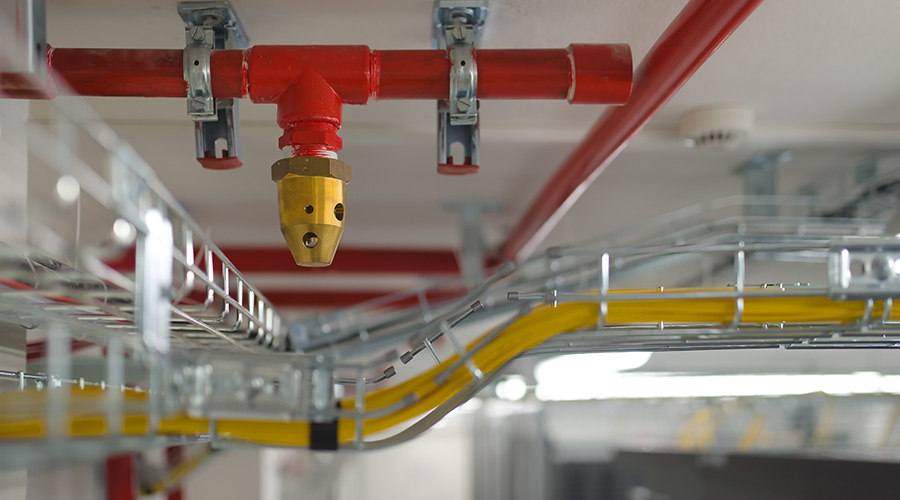Know Your Fire Alarm Codes
Do you know which codes apply to fire alarm systems?
By Wayne D. Moore and Larry D. Rietz, Contributing Writers
Building codes have historically been developed to help avoid large conflagrations in our cities. In the United States, the most universally adopted building code is the International Building Code (IBC) published by the International Code Council (ICC). The ICC publishes a host of codes including fire, plumbing, and mechanical codes. Codes and standards specifically related to fire and life safety are also published by the National Fire Protection Association (NFPA).
The codes published by these entities are updated every three years and then state or local jurisdictions must adopt these codes. Often the codes that are adopted by the state or local jurisdiction are several years behind the currently published code. In some instances, the local authority having jurisdiction (often called the AHJ) is using a completely different code locally than what is adopted statewide.
When a state, county, or city adopts a building code, it becomes law in that jurisdiction. As a result, all NFPA codes and standards referenced by the adopted building code are also law and must be followed.
Different jurisdictions follow different editions of building codes and in some cases different codes altogether, so it is important for you, as a facility manager, to know what is adopted in your jurisdiction. This information can often be located on your city, county, or state website or from your local fire or building department. In addition, there are special codes that are adopted by authorities that only apply to that local jurisdiction.
What codes apply to fire alarm systems?
A wide range of codes and regulations apply to the fire alarm system, including the International Building Code, the International Fire Code, Occupational Health and Safety Administration (OSHA) regulations, NFPA codes and standards, NEC, local codes, elevator codes, and others. Each one of those examples will have references to fire alarm systems.
In most states, for new building construction, the International Building Code (IBC) will mandate when and what type of fire alarm system is required in each occupancy type. The International Fire Code (IFC) will do the same for existing occupancies and in addition have the system maintenance requirements spelled out.
NFPA publishes NFPA 1, Fire Code, that is essentially equal to the IFC and some jurisdictions will adopt it in place of the IFC. Other states or jurisdictions may adopt different or additional codes. For example, some states, in addition to adopting the IBC, will also adopt NFPA 101, Life Safety Code, but may only reference the existing requirements of that code. In healthcare occupancies, NFPA 101, Life Safety Code, is required to be followed by the Joint Commission (for healthcare occupancies) in addition to the local building code.
All the above codes will reference NFPA 72 for fire alarm system installation requirements and NFPA 70 the National Electrical Code, or NEC, for electrical installation requirements. The NEC, Article 760, has all the electrical wiring installation information for fire alarm systems.
OSHA regulations will have fire alarm system requirements for all industrial facilities and will often include different and more stringent (than the IBC and IFC) requirements for the fire alarm system and for the sound output limits for notification appliances.
Elevator codes, like ASME A17.1, will have the interface requirements for the elevator operation during an alarm condition which are correlated with the NFPA 72 requirements. Local building codes and amendments are obviously important to know about and generally reinforce the requirements of NFPA 72.
A more recent standard that is now being enforced for construction projects is NFPA 241, Standard for Safeguarding Construction, Alteration, and Demolition Operations. Many jurisdictions require that NFPA 241 documentation be developed and submitted to the fire department before any new construction or alteration work can begin.
Who determines what kind of fire alarm and/or suppression system I should have?
The answer is somewhat different depending on whether you are dealing with new or existing construction.
In new construction, the IBC (or other building code) adopted in your jurisdiction will dictate both systems’ minimum requirements. The facility’s corporate fire protection goals will also play a major part in the choice of systems. However, in almost all cases for existing buildings, the AHJ will have a large say in determining the minimal requirements for, and the kind of, fire alarm system or fire suppression system that is to be installed in your building, as well as how those systems must be maintained.
Wayne D. Moore is a licensed professional fire protection engineer with over 45 years of engineering experience. Moore currently serves on the NFPA 72 Correlating Committee and Chapter 24 Technical Committee (past Chair), as well as being an editor of five editions of the “National Fire Alarm Code Handbook.”
Larry D. Rietz, is a NICET Level IV Certified fire alarm designer with more than 29 years of life safety industry experience. Rietz is Vice President and Global Service Line Leader for Fire Detection and Alarm for Jensen Hughes and serves on the NFPA 72 Chapter 24 and 12, 21, & 23 Technical Committees.
Related Topics:












